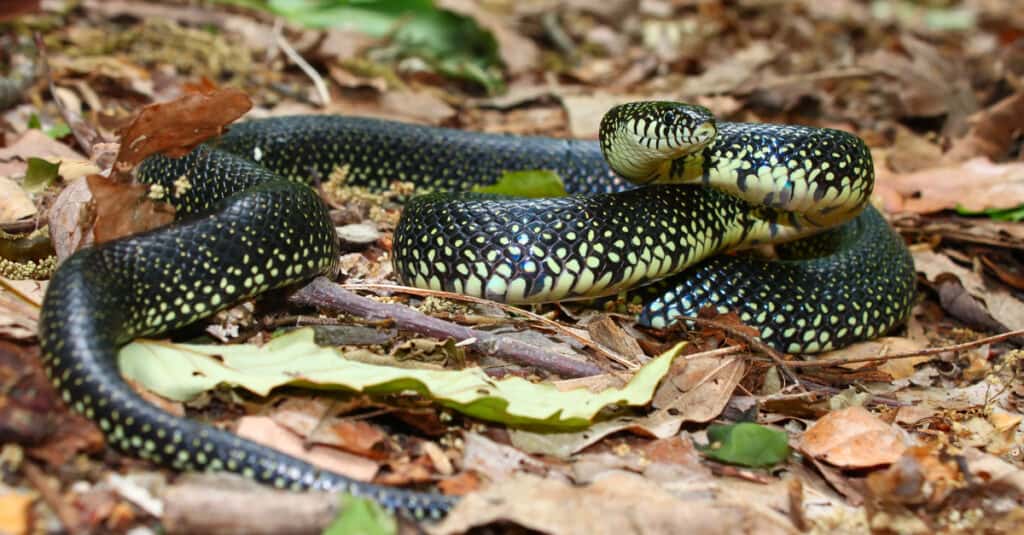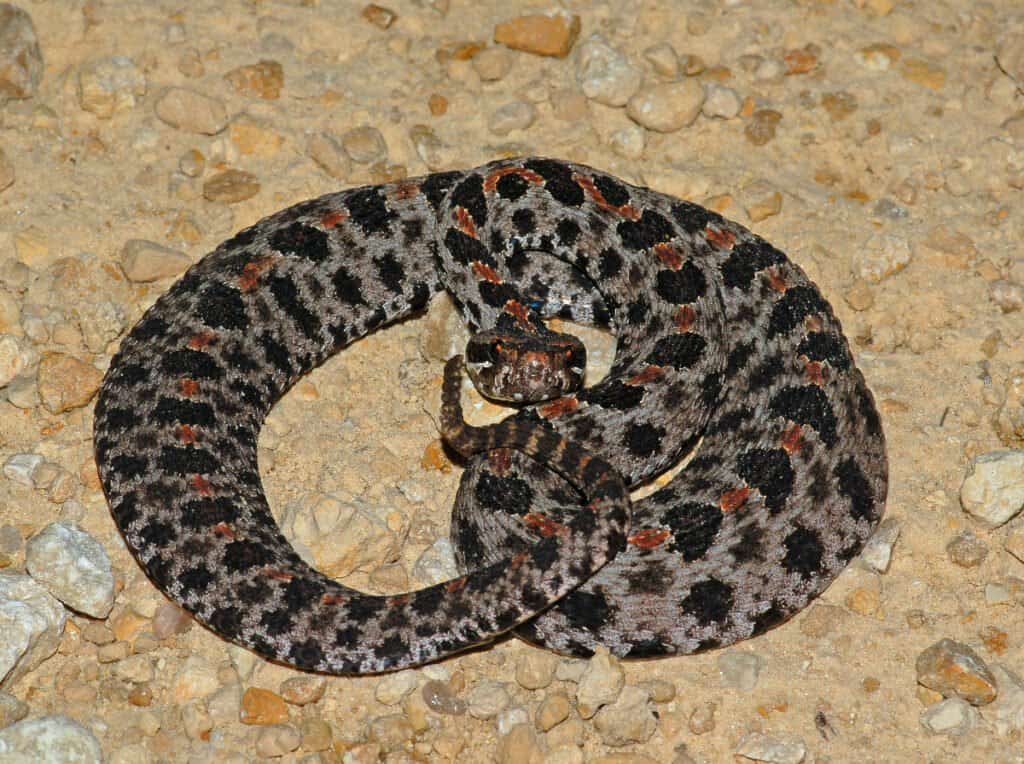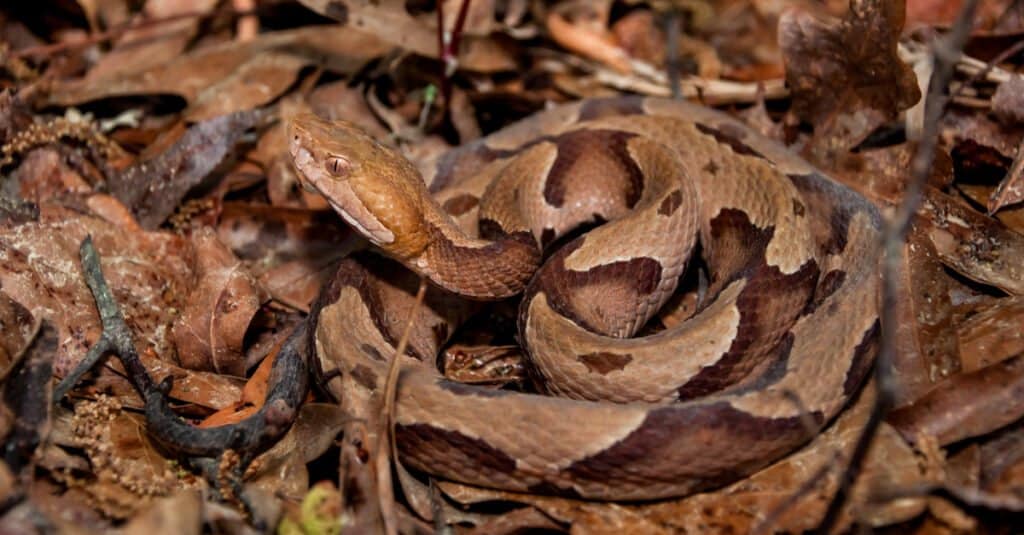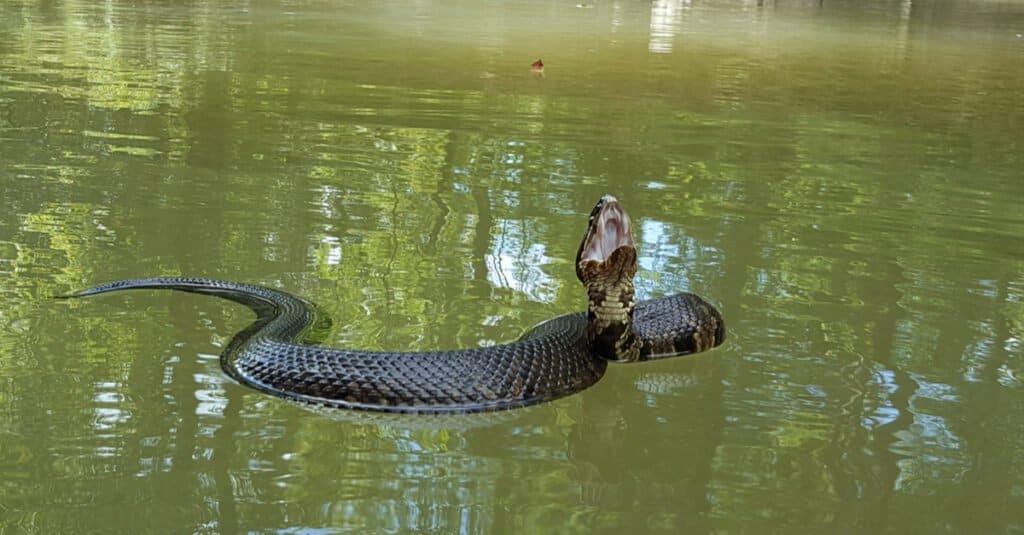Discover the 4 Poisonous Snakes in Tennessee
#mobileSnakeQuizControls { overflow: hidden; text-overflow: ellipsis; white-space: nowrap; }
@media (min-width: 481px) {
.mobile-top-content {
display: none;
}
}
#mobileTopContentCTACarouselControls { overflow: hidden; text-overflow: ellipsis; white-space: nowrap; }
.mobile-top-content .more { color: #fff; }
.mobile-top-content a { color: #fff; text-decoration: underline; }
.mobile-top-content a:hover { color: #fff; text-decoration: underline; }
@media (max-width: 480px) {
.mobile-top-content {
background-color: #06a10b;
color: #fff;
text-align: center;
/*height: 60px;
padding-top:5px;*/
font-size:80%;
/* display: block; */
margin: 0px -30px;
}
}
Key Points:
- Tennessee has plenty of natural spaces for wildlife to live, including 4 species of venomous snakes.
- Rattlesnakes, Coral Snakes, Cottonmouths, Copperheads are venomous snake species in the state.
- Keeping an eye out for snakes when outdoors and avoiding them if seen are the best ways to avoid being bitten.
Tennessee is a beautiful state that is home to the Smoky Mountains and various gorgeous wildlife. Although you can admire the many types of animals in this part of the country, the truth is that some creatures are more dangerous than others. Hikers, in particular, need to watch out for the venomous snakes in Tennessee. We’re going to take a look at the four venomous snakes in the area that can send you to the hospital or worse!
What Venomous Snakes Live in the United States?

Jay Ondreicka/Shutterstock.com
button.pulse {
transform: scale(1); animation: pulse 2s infinite;
box-shadow: 0 0 0 0 rgba(11, 247, 25, 1);
}
@keyframes pulse {
0% { transform: scale(0.90); box-shadow: 0 0 0 0 rgba(11, 247, 25, 0.5); }
60% { transform: scale(1); box-shadow: 0 0 0 15px rgba(11, 247, 25, 0); }
100% { transform: scale(0.90); box-shadow: 0 0 0 0 rgba(11, 247, 25, 0); }
}
The United States is home to only four genera of venomous snakes. The four types of venomous snakes that reside in the U.S. include:
Each of these four snakes is dangerous for different reasons. Rattlesnakes have deadly hemotoxic venom. Coral snakes are rare but have an unusually deadly venom. Cottonmouths can be aggressive, and they live near water; they’re the bane of fishers. Copperheads blend in with leaves and dirt, so many people accidentally tread on them and receive a bite.
All these snakes are dangerous, but not all of them are present in the state of Tennessee. Let’s take a closer look at this area.
How Many Types of Snakes Live in Tennessee?

Jason Patrick Ross/Shutterstock.com
The state of Tennessee is home to about 32 species of snake. Some of these animals are commonly seen, like the North American racer, but others are rarer. Out of the 32 snakes in the area, only four of them are venomous.
These four snakes should be avoided because they can cause severe disabilities or death when they bite people. Let’s identify the snakes you need to avoid.
The 4 Poisonous Snakes in Tennessee
The four poisonous snakes in Tennessee are the copperhead, cottonmouth, pygmy rattlesnake, and timber rattlesnake. We’re going to take a closer look at each of these animals, so you can identify them and stay safe.
Timber Rattlesnake

Tim Malek/Shutterstock.com
| Size | Color | Unique Qualities |
|---|---|---|
| 3ft-7ft long | – Dark zig-zag patterns set against brown, gray, or pinkish skin | – Known for its rattling and defense posture – Snake does not always rattle before biting |
Timber rattlesnakes are among the most common venomous snakes that you’ll find in Tennessee. They are capable of delivering a fatal bite to human beings. These snakes can grow between 3ft and 7ft long, and their bodies are thick in the middle.
Most of the time, people run into these snakes when the animals are basking on rocks trying to stay warm or when they reach around areas in which they hide. These snakes have dark bodies that allow them to blend in with some of their surroundings. It’s possible to get too close to these snakes without knowing.
Rattlesnakes do not have to rattle before they strike. Moreover, they may not rattle at all when you suddenly come upon them. If you get too close to a timber rattlesnake, it will often let you know by engaging the muscles near its rattle. The result is a rapid rattling sound that most people in the southern United States know about. If you hear this rattling noise, it’s best to stop, identify where the sound is coming from, and retreat.
Pygmy Rattlesnake

Gerald A. DeBoer/Shutterstock.com
| Size | Color | Unique Qualities |
|---|---|---|
| 1ft-2ft long | – Gray base color with an orange and brown stripe running down the middle – Brown splotches down the length of the body |
– Has a rattle on the end of its tail – Thich-bodied like other rattlesnakes |
As the name suggests, pygmy rattlesnakes are small but potentially harmful snakes. Although their venom may not be as toxic as the timber rattlesnake’s venom, they can hurt or potentially kill humans. Aside from the size, these rattlesnakes differ in other ways, too.
For example, most rattlesnakes are very dark in color, but pygmy rattlesnakes have bright orange integrated into their colors. An orange band runs down their back. Another difference is the sound their rattle makes. Unlike the distinct rattle of a timber rattlesnake, the noise from a pygmy rattlesnake is said to resemble an insect buzzing. This noise is noticeable, though.
The pygmy rattlesnake is becoming increasingly rare throughout Tennessee, so your chances of running into one are very low.
Copperhead Snake

Jay Ondreicka/Shutterstock.com
| Size | Color | Unique Qualities |
|---|---|---|
| 2ft-4ft long | – Brown, tan, yellow – Dark brown or red hourglass-shaped blotches on its back – Blend in well with leaves and soil |
– Great camouflage in dirt and debris |
Copperhead snakes are common in the eastern portion of Tennessee. They are usually found in forests and may be seen near water. They maintain the dark brown or dark red hourglass-shaped blotches on their back seen with other copperheads. However, they tend to be a little darker than their name suggests in this neck of the woods.
Copperheads do not like confrontations. Still, they are sometimes stepped on because they tend to blend in with dirt and debris outside. These snakes are very rarely fatal, even if they bite someone.
Cottonmouth

Seth LaGrange/Shutterstock.com
| Size | Color | Unique Qualities |
|---|---|---|
| – Between 2-3ft long – May grow up to 5ft long |
– Olive, black, brown | – The inside of their mouths is white – Patch of white on the chin – Arrow-shaped head |
Cottonmouth snakes are also called water moccasins, and their defensive posturing helped give them their name. They will often open their mouths to scare off foes like humans, showing the white interior. Sometimes, they will bluff charge, which has led to some people overplaying their aggressiveness.
You’ll often find these snakes near water, so fishers need to watch out for them. They’re black or dark green, and it can be hard to spot them in mud or on rocks. Other water snakes are often mistaken for cottonmouths. Any snake that cannot be identified should be left alone and given its space.
How Many People are Bitten in TN?
Yearly, there are only around 50 snake bites reported in Tennessee. Out of these bites, copperheads are mostly responsible. Luckily, copperheads have a mild venom but can still result in a trip to the hospital and some discomfort following.
Avoiding bites from the poisonous snakes in Tennessee is often a matter of not bothering the animals and paying attention to one’s surroundings. Most snakes would rather not waste their venom on a human. Yet, if you persist after a warning rattle or put your hands or feet somewhere without looking, you can be in danger.
Summary: Venomous Snakes in TN
| Rank | Species |
|---|---|
| 1 | Timber Rattlesnake |
| 2 | Pygmy Rattlesnake |
| 3 | Cottonmouths |
| 4 | Copperheads |
Up Next…
If you’re planning a trip to the beautiful state of Tennessee, it is important to learn about the wildlife living in the state. Check out these articles for further insight on what to expect when visiting!
- Animals in Tennessee – Rolling hills, woodlands, and mountains are home to countless wildlife in the state of TN.
- 10 Spiders in Tennessee – Snakes aren’t the only creepy crawlies in Tennessee!
- The 5 Biggest Fish in Tennessee – Fishing in Tennessee rivers and lakes is a fun pastime, here are the species to look forward to catching!
Discover the “Monster” Snake 5X Bigger than an Anaconda
Every day A-Z Animals sends out some of the most incredible facts in the world from our free newsletter. Want to discover the 10 most beautiful snakes in the world, a “snake island” where you’re never more than 3 feet from danger, or a “monster” snake 5X larger than an anaconda? Then sign up right now and you’ll start receiving our daily newsletter absolutely free.
More from A-Z Animals
.more-snake-card-image { max-height:140px !important; }
#mobileSnakeQuizControls { overflow: hidden; text-overflow: ellipsis; white-space: nowrap; }
@media (min-width: 481px) {
.mobile-top-content {
display: none;
}
}
#mobileTopContentCTACarouselControls { overflow: hidden; text-overflow: ellipsis; white-space: nowrap; }
.mobile-top-content .more { color: #fff; }
.mobile-top-content a { color: #fff; text-decoration: underline; }
.mobile-top-content a:hover { color: #fff; text-decoration: underline; }
@media (max-width: 480px) {
.mobile-top-content {
background-color: #06a10b;
color: #fff;
text-align: center;
/*height: 60px;
padding-top:5px;*/
font-size:80%;
/* display: block; */
margin: 0px -30px;
}
}
Key Points:
- Tennessee has plenty of natural spaces for wildlife to live, including 4 species of venomous snakes.
- Rattlesnakes, Coral Snakes, Cottonmouths, Copperheads are venomous snake species in the state.
- Keeping an eye out for snakes when outdoors and avoiding them if seen are the best ways to avoid being bitten.
Tennessee is a beautiful state that is home to the Smoky Mountains and various gorgeous wildlife. Although you can admire the many types of animals in this part of the country, the truth is that some creatures are more dangerous than others. Hikers, in particular, need to watch out for the venomous snakes in Tennessee. We’re going to take a look at the four venomous snakes in the area that can send you to the hospital or worse!
What Venomous Snakes Live in the United States?

Jay Ondreicka/Shutterstock.com
button.pulse {
transform: scale(1); animation: pulse 2s infinite;
box-shadow: 0 0 0 0 rgba(11, 247, 25, 1);
}
@keyframes pulse {
0% { transform: scale(0.90); box-shadow: 0 0 0 0 rgba(11, 247, 25, 0.5); }
60% { transform: scale(1); box-shadow: 0 0 0 15px rgba(11, 247, 25, 0); }
100% { transform: scale(0.90); box-shadow: 0 0 0 0 rgba(11, 247, 25, 0); }
}
The United States is home to only four genera of venomous snakes. The four types of venomous snakes that reside in the U.S. include:
Each of these four snakes is dangerous for different reasons. Rattlesnakes have deadly hemotoxic venom. Coral snakes are rare but have an unusually deadly venom. Cottonmouths can be aggressive, and they live near water; they’re the bane of fishers. Copperheads blend in with leaves and dirt, so many people accidentally tread on them and receive a bite.
All these snakes are dangerous, but not all of them are present in the state of Tennessee. Let’s take a closer look at this area.
How Many Types of Snakes Live in Tennessee?

Jason Patrick Ross/Shutterstock.com
The state of Tennessee is home to about 32 species of snake. Some of these animals are commonly seen, like the North American racer, but others are rarer. Out of the 32 snakes in the area, only four of them are venomous.
These four snakes should be avoided because they can cause severe disabilities or death when they bite people. Let’s identify the snakes you need to avoid.
The 4 Poisonous Snakes in Tennessee
The four poisonous snakes in Tennessee are the copperhead, cottonmouth, pygmy rattlesnake, and timber rattlesnake. We’re going to take a closer look at each of these animals, so you can identify them and stay safe.
Timber Rattlesnake

Tim Malek/Shutterstock.com
| Size | Color | Unique Qualities |
|---|---|---|
| 3ft-7ft long | – Dark zig-zag patterns set against brown, gray, or pinkish skin | – Known for its rattling and defense posture – Snake does not always rattle before biting |
Timber rattlesnakes are among the most common venomous snakes that you’ll find in Tennessee. They are capable of delivering a fatal bite to human beings. These snakes can grow between 3ft and 7ft long, and their bodies are thick in the middle.
Most of the time, people run into these snakes when the animals are basking on rocks trying to stay warm or when they reach around areas in which they hide. These snakes have dark bodies that allow them to blend in with some of their surroundings. It’s possible to get too close to these snakes without knowing.
Rattlesnakes do not have to rattle before they strike. Moreover, they may not rattle at all when you suddenly come upon them. If you get too close to a timber rattlesnake, it will often let you know by engaging the muscles near its rattle. The result is a rapid rattling sound that most people in the southern United States know about. If you hear this rattling noise, it’s best to stop, identify where the sound is coming from, and retreat.
Pygmy Rattlesnake

Gerald A. DeBoer/Shutterstock.com
| Size | Color | Unique Qualities |
|---|---|---|
| 1ft-2ft long | – Gray base color with an orange and brown stripe running down the middle – Brown splotches down the length of the body |
– Has a rattle on the end of its tail – Thich-bodied like other rattlesnakes |
As the name suggests, pygmy rattlesnakes are small but potentially harmful snakes. Although their venom may not be as toxic as the timber rattlesnake’s venom, they can hurt or potentially kill humans. Aside from the size, these rattlesnakes differ in other ways, too.
For example, most rattlesnakes are very dark in color, but pygmy rattlesnakes have bright orange integrated into their colors. An orange band runs down their back. Another difference is the sound their rattle makes. Unlike the distinct rattle of a timber rattlesnake, the noise from a pygmy rattlesnake is said to resemble an insect buzzing. This noise is noticeable, though.
The pygmy rattlesnake is becoming increasingly rare throughout Tennessee, so your chances of running into one are very low.
Copperhead Snake

Jay Ondreicka/Shutterstock.com
| Size | Color | Unique Qualities |
|---|---|---|
| 2ft-4ft long | – Brown, tan, yellow – Dark brown or red hourglass-shaped blotches on its back – Blend in well with leaves and soil |
– Great camouflage in dirt and debris |
Copperhead snakes are common in the eastern portion of Tennessee. They are usually found in forests and may be seen near water. They maintain the dark brown or dark red hourglass-shaped blotches on their back seen with other copperheads. However, they tend to be a little darker than their name suggests in this neck of the woods.
Copperheads do not like confrontations. Still, they are sometimes stepped on because they tend to blend in with dirt and debris outside. These snakes are very rarely fatal, even if they bite someone.
Cottonmouth

Seth LaGrange/Shutterstock.com
| Size | Color | Unique Qualities |
|---|---|---|
| – Between 2-3ft long – May grow up to 5ft long |
– Olive, black, brown | – The inside of their mouths is white – Patch of white on the chin – Arrow-shaped head |
Cottonmouth snakes are also called water moccasins, and their defensive posturing helped give them their name. They will often open their mouths to scare off foes like humans, showing the white interior. Sometimes, they will bluff charge, which has led to some people overplaying their aggressiveness.
You’ll often find these snakes near water, so fishers need to watch out for them. They’re black or dark green, and it can be hard to spot them in mud or on rocks. Other water snakes are often mistaken for cottonmouths. Any snake that cannot be identified should be left alone and given its space.
How Many People are Bitten in TN?
Yearly, there are only around 50 snake bites reported in Tennessee. Out of these bites, copperheads are mostly responsible. Luckily, copperheads have a mild venom but can still result in a trip to the hospital and some discomfort following.
Avoiding bites from the poisonous snakes in Tennessee is often a matter of not bothering the animals and paying attention to one’s surroundings. Most snakes would rather not waste their venom on a human. Yet, if you persist after a warning rattle or put your hands or feet somewhere without looking, you can be in danger.
Summary: Venomous Snakes in TN
| Rank | Species |
|---|---|
| 1 | Timber Rattlesnake |
| 2 | Pygmy Rattlesnake |
| 3 | Cottonmouths |
| 4 | Copperheads |
Up Next…
If you’re planning a trip to the beautiful state of Tennessee, it is important to learn about the wildlife living in the state. Check out these articles for further insight on what to expect when visiting!
- Animals in Tennessee – Rolling hills, woodlands, and mountains are home to countless wildlife in the state of TN.
- 10 Spiders in Tennessee – Snakes aren’t the only creepy crawlies in Tennessee!
- The 5 Biggest Fish in Tennessee – Fishing in Tennessee rivers and lakes is a fun pastime, here are the species to look forward to catching!
Discover the “Monster” Snake 5X Bigger than an Anaconda
Every day A-Z Animals sends out some of the most incredible facts in the world from our free newsletter. Want to discover the 10 most beautiful snakes in the world, a “snake island” where you’re never more than 3 feet from danger, or a “monster” snake 5X larger than an anaconda? Then sign up right now and you’ll start receiving our daily newsletter absolutely free.







